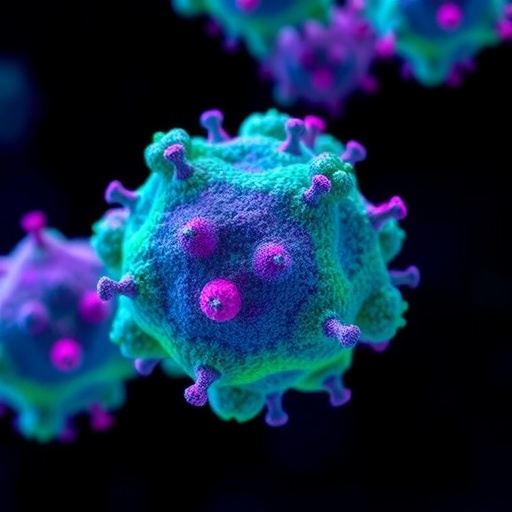In the ever-evolving landscape of drug delivery systems, recent advancements have manifested in the innovative fabrication of poly-L-histidine-coated mesoporous silica nanoparticles (MSNs). This groundbreaking research, orchestrated by a team of experts led by Karmacharya, Shrestha, and Kim, opens new avenues in targeted therapy, particularly in the context of doxorubicin delivery for cancer treatment. Doxorubicin, a widely used chemotherapeutic agent, often presents challenges related to systemic toxicity and drug resistance. The development of a more efficient delivery system aims to enhance the therapeutic index of doxorubicin while minimizing its adverse effects.
The fabrication method employs poly-L-histidine, an amino acid with unique biocompatibility properties, which serves a dual purpose in this context. First, the poly-L-histidine coating not only stabilizes the mesoporous silica nanoparticles but also facilitates the effective loading of doxorubicin due to the interactions between the drug and the polymer. This interaction is pivotal for controlled drug release, ensuring that the therapeutic agent is delivered precisely where it is needed, thereby augmenting the drug’s efficacy against cancer cells.
In addition to the poly-L-histidine, the inclusion of hyaluronic acid in the formulation adds another layer of sophistication. Hyaluronic acid is known for its affinity towards CD44 receptors, which are overexpressed in various cancer cells. By conjugating hyaluronic acid to the surface of the mesoporous silica nanoparticles, the researchers enhance the nanoparticles’ targeting capability, allowing them to specifically home in on malignant cells and tissues. This targeted approach is crucial in reducing the collateral damage to healthy cells, which is often a significant drawback of traditional chemotherapy.
The mesoporous silica nanoparticles themselves exhibit remarkable properties due to their large surface area and tunable pore structure. These characteristics not only allow for a high drug loading capacity but also facilitate the sustained release of doxorubicin. The intricate mesoporous architecture ensures that once the nanoparticles are internalized by the cancer cells, the intracellular release of the drug can be finely tuned to match the biological requirements, potentially overcoming instances of drug resistance that affect treatment outcomes.
Moreover, the encapsulation of doxorubicin within the nanoparticles shields the drug from premature degradation in the bloodstream, which is a common challenge faced during intravenous administration. This encapsulation strategy enables the preservation of the drug’s potency until it reaches its intended destination. The researchers meticulously outlined the synthesis process of these nanoparticles, detailing the precise ratios of materials used and the conditions optimized for maximum loading efficiency and surface functionalization.
A crucial aspect of this research also involves an assessment of the biocompatibility and safety of the newly developed nanoparticles. In vitro studies were conducted to evaluate cytotoxicity on both cancer and normal cell lines, providing essential insights into the selective action of the drug delivery system. The results indicated that while doxorubicin-loaded nanoparticles effectively inhibited cancer cell proliferation, they exhibited minimal toxicity towards healthy cells, corroborating the hypothesis that targeted delivery significantly reduces adverse effects.
It’s also worth noting that the researchers employed state-of-the-art characterization techniques to confirm the successful fabrication of the nanoparticles, including transmission electron microscopy (TEM) and dynamic light scattering (DLS). These techniques allowed for a comprehensive understanding of the size distribution, morphology, and surface properties of the nanoparticles, ensuring that the design meets the requisite criteria for effective drug delivery applications.
The implications of this research extend beyond just the realm of cancer therapy. The targeted drug delivery system has the potential to be adapted for a variety of therapeutic agents, including other chemotherapeutics and biologics. In this sense, the versatility of mesoporous silica nanoparticles makes them a promising candidate for broadening the scope of targeted therapies across different diseases, potentially paving the way for customized treatments based on individual patient needs.
As the research progresses towards clinical trials, it is critical to gather extensive data regarding pharmacokinetics and overall therapeutic efficacy. To this end, animal studies will play a pivotal role in translating these laboratory results into potential clinical applications. Engaging in such translational research underscores the importance of innovation in drug delivery systems and their ability to transform the landscape of cancer treatment.
This study is a testament to the collaborative efforts of scientists and researchers who strive to tackle the complexities of drug delivery. Their collective work exemplifies how interdisciplinary approaches can catalyze advancements in medicine, ultimately leading to improved patient outcomes and more effective cancer treatments. The future of targeted drug delivery appears promising as ongoing research continues to refine and enhance the capabilities of nanotechnology in pharmaceutical applications.
In conclusion, the innovative fabrication of poly-L-histidine-coated mesoporous silica nanoparticles holds the potential to reshape targeted therapy for doxorubicin. By enhancing drug loading and release mechanisms while ensuring targeted delivery to cancer cells, these nanoparticles may not only alleviate the side effects associated with traditional chemotherapy but also revolutionize the effectiveness of cancer treatment. The journey from laboratory synthesis to clinical application marks an exciting frontier in the battle against cancer, with the promising prospect of improved survival outcomes for patients.
The underlying research embodies the spirit of scientific inquiry and innovation, addressing the pressing challenges faced in oncological therapies. By harnessing the unique properties of mesoporous silica nanoparticles and combining them with biocompatible polymers such as poly-L-histidine and hyaluronic acid, the findings pave the way for more targeted, effective, and personalized treatment options in oncology and beyond.
Subject of Research: Targeted drug delivery systems using mesoporous silica nanoparticles for cancer treatment.
Article Title: Fabrication of poly-L-histidine-coated mesoporous silica nanoparticles with hyaluronic acid for targeted doxorubicin delivery.
Article References:
Karmacharya, P., Shrestha, A., Kim, B. et al. Fabrication of poly-L-histidine-coated mesoporous silica nanoparticles with hyaluronic acid for targeted doxorubicin delivery.
J. Pharm. Investig. (2025). https://doi.org/10.1007/s40005-025-00773-3
Image Credits: AI Generated
DOI: 10.1007/s40005-025-00773-3
Keywords: mesoporous silica nanoparticles, targeted drug delivery, doxorubicin, poly-L-histidine, hyaluronic acid, cancer therapy.




